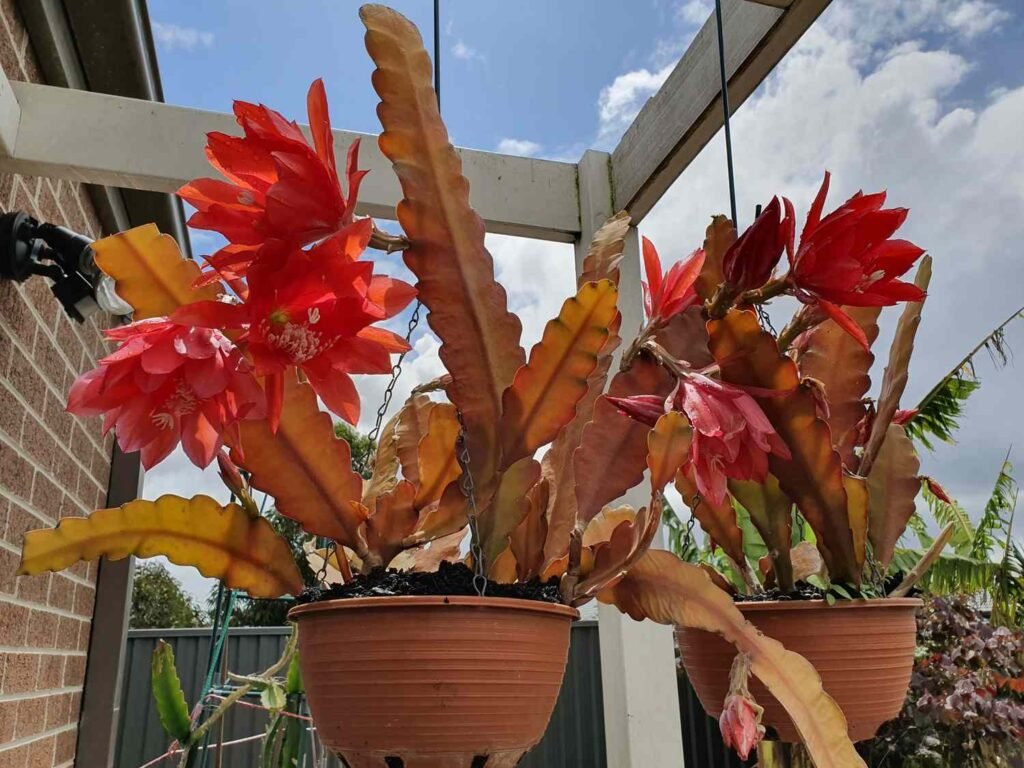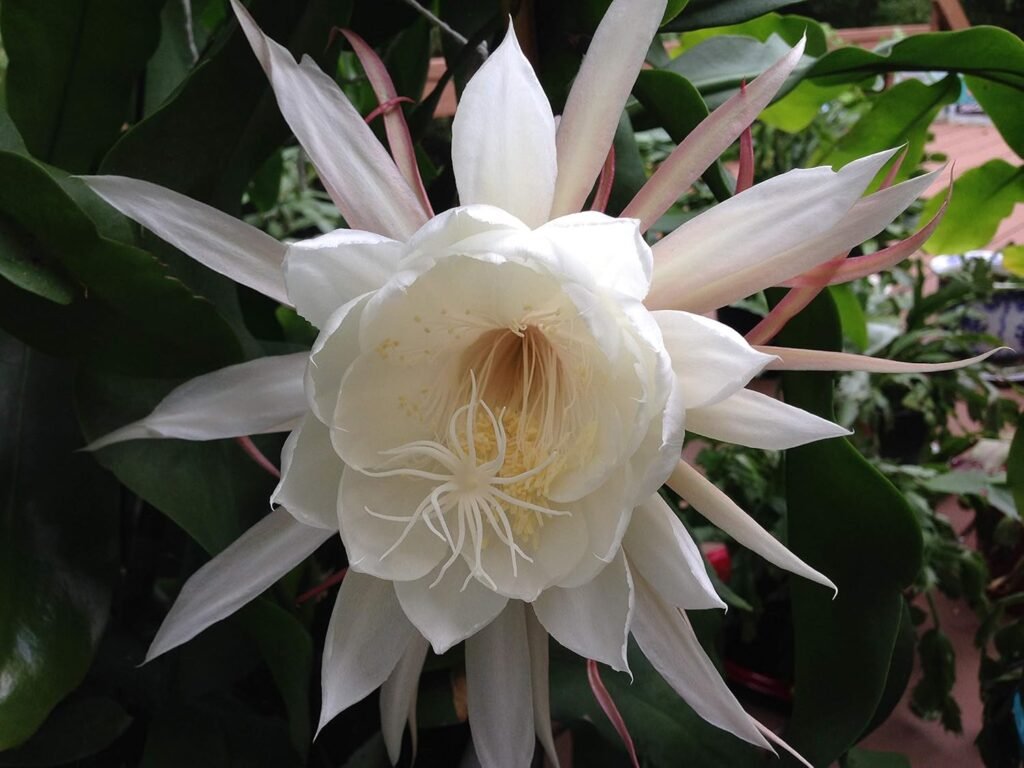Imagine a flower so rare, so magical, that it blooms just once a year—only at night—and fades away before the sun rises. Sounds like a scene from a fairy tale, right?
Welcome to the world of the Queen of the Night Orchid flower, a plant that captures hearts with its fleeting beauty and mysterious charm.
Let’s take you on a journey into the moonlit world of this enchanting bloom.
What Exactly Is the Queen of the Night Orchid?
Despite the name, the Queen of the Night Orchid isn’t actually a true orchid. Its botanical name is Epiphyllum oxypetalum, and it’s a member of the cactus family.
Commonly known as the Queen of the Night, Dutchman’s Pipe Cactus, or Night-Blooming Cereus, this flower is native to the tropical rainforests of Central and South America.
Unlike most flowers that seek the warmth of the day, this one prefers the spotlight of the stars. And when it finally decides to show up, it steals the show.
The Magic of Midnight Blooming

This plant is famous for one thing—it blooms at night. Not just any night, though. Just one night in the entire year, and sometimes, only for a few hours. It’s a dramatic entrance, to say the least.
By 10 PM, its large white petals start to unfold. By midnight, it’s fully open, emitting a sweet, heady fragrance that floats through the air. By sunrise? It’s all gone. The bloom wilts and disappears, leaving you wondering if you ever really saw it.
No wonder people throw “bloom watch parties” to catch this once-in-a-year spectacle!
Blooming Season: Typically in late spring to summer, but only once a year
Bloom Time: Evening to early morning (roughly 6–8 hours)
Pro Tip: If you own one, keep your phone or camera handy during bloom season—you won’t get a second chance for photos until next year!
What Does It Look Like?
The Queen of the Night produces a massive, trumpet-shaped flower—often 6 to 12 inches wide. It’s pure white, silky in texture, and glows beautifully in the dark.
The petals look like delicate layers of moonlight, and the scent? A rich, floral perfume that’s hard to describe but impossible to forget.
Its leaves are flat and cactus-like, though they resemble long green ribbons rather than traditional cactus spikes.
When Does It Bloom?
Typically, the bloom happens between June and August, depending on your location and the plant’s growing conditions. Many plant lovers claim that the bloom is often timed around a full moon, high humidity, or a particularly warm day.
The anticipation of “will it bloom tonight?” is part of the fun—and the mystery.
A Flower Full of Meaning
In many cultures, the Queen of the Night holds a spiritual or poetic significance. In India and other Asian countries, the flower is considered a symbol of good luck and divine blessings. Because it blooms so briefly, it’s also seen as a metaphor for fleeting beauty and living in the moment.
Poets love it. Gardeners adore it. Dreamers relate to it.
How to Grow a Queen of the Night at Home

Surprisingly, growing this flower isn’t too hard if you give it what it loves.
1. Light: Bright, indirect sunlight is perfect. Avoid harsh afternoon rays.
2. Soil: Use well-draining cactus or succulent mix.
3. Water: Water only when the top inch of soil is dry. Don’t overdo it—this is still a cactus.
4. Temperature: Warm climates are best (60°F–85°F or 15°C–30°C).
5. Humidity: It loves a bit of humidity, especially in summer.
6. Fertilizer: Feed with a balanced houseplant fertilizer monthly during growing season (spring/summer).
Give it some room to grow—it can become quite large and will need support as it matures.
Propagation & Care Tips
Want to grow more? Just snip off a healthy stem, let it dry for a couple of days, then plant it in moist soil. It’s that simple.
Also, don’t be afraid to prune. Trimming after the bloom can encourage better growth next season.
Prune after blooming to encourage branching and more flower sites. Repot every 2–3 years when roots outgrow the pot.
Common Issues and Solutions
- No blooms? Could be a light issue or the pot is too small.
- Yellowing leaves? You might be overwatering.
- Pests? Occasionally, you may see mealybugs or spider mites—treat them with neem oil or insecticidal soap.
Fun Facts About the Queen of the Night
- It can live up to 20 years with proper care.
- Some enthusiasts livestream its bloom event.
- It’s featured in stories and folklore across Asia and Latin America.
- The bloom attracts moths and bats, which are its natural pollinators.
Why It’s So Special
- Rarity: Blooms just once a year, often only on a single night
- Size: The flower can span 8 to 10 inches across
- Fragrance: Its sweet, hypnotic scent is often described as a mix of jasmine, gardenia, and vanilla
- Symbolism: Often symbolizes mystery, beauty, and fleeting moments in Eastern cultures
In many Asian traditions, seeing the Queen of the Night bloom is considered lucky or even sacred.

Cultural Significance
In countries like India, China, and Thailand, the Queen of the Night holds spiritual value. In some regions, it’s called the “Brahma Kamal” and is believed to bloom only in the presence of divine energy. It’s often used in religious rituals and is associated with new beginnings, good fortune, and hope.
Where to Find It
You can buy Queen of the Night plants or cuttings online from specialty nurseries or cactus sellers. If you’re just curious to see one in bloom, some botanical gardens showcase them during summer evenings—just check their event calendars.
Final Thoughts
The Queen of the Night Orchid is more than just a flower—it’s an experience. It teaches patience, presence, and the beauty of rare moments. If you’re lucky enough to see one bloom, you’ll understand why people stay up late just to catch a glimpse.
It’s nature’s version of a surprise party—short, stunning, and totally unforgettable.
